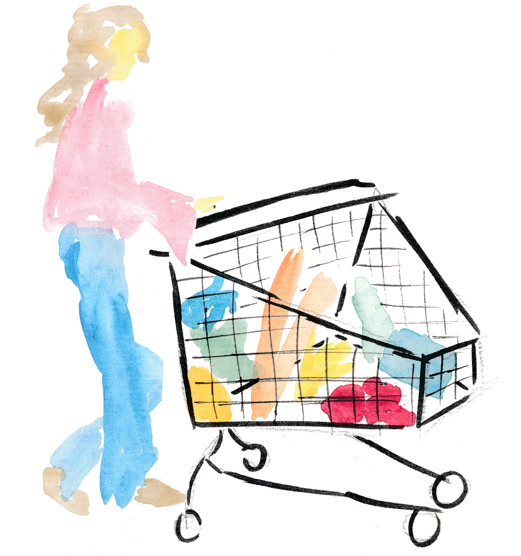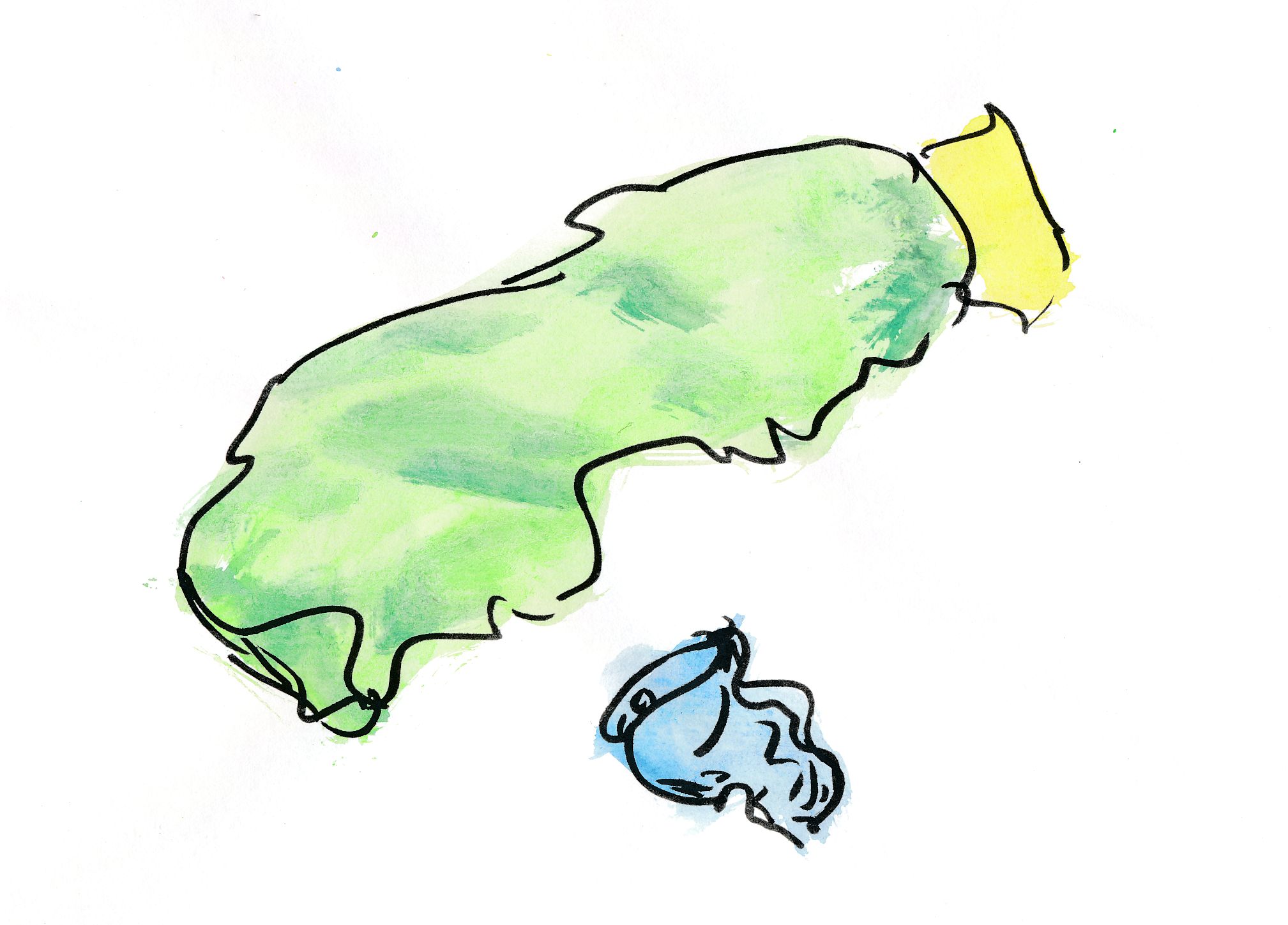
Please activate JavaScript for the audio player.
Module 6 - Shopping

All illustrations except the background image: © fbw4/Julia Beckel, available under the Creative Commons Licence BY-NC-SA.
1. Shopping and consumption
Shopping means buying things that we need or want, such as food, clothes, or gadgets. We shop because we need to live and be healthy, but also because we want to be happy and comfortable. We shop different things in different places, depending on our budget, taste, and convenience. We can make a big difference for the planet when we care for sustainability while shopping.
2. What can be the problem with shopping?
Many products are either bad for the planet or bad for the people who make them:
- Environmentally harmful production
The production of many products is very harmful to the environment: for example, a lot of toxic paint is used in the production of clothing. If this is produced in countries where there are no rules for the companies that protect the environment, it is very bad for the environment and for the people who live there. It's also bad for your body.
- Environmentally harmful ingredients
Many things contain ingredients that cannot be recycled later or are harmful to the environment. Take microplastics, for example. These are very small plastic particles that get everywhere and make the earth, animals, plants and people sick.
- Unfair working conditions
In many countries, there is also no protection for the people who produce the resources for the products or who manufacture the products themselves. This can mean that people have to work far too long or receive far too little money for their labour. They may also have to work in conditions that make them ill. Or if they are ill, they may lose their job. That is unfair. There are also countries where children are forced to work hard. That should not be the case.
3. What is sustainable shopping and why is it good?
Sustainable shopping means buying things in a way that does not harm the environment or the people, now or in the future. Sustainable shopping is good because it helps us to use less resources and create less waste. It also helps us to support fair, ecological and ethical businesses that care for the planet and the people. Sustainable shopping also helps us to save money, time, and space. It also makes us feel good about ourselves and our choices.
4. What can you do to do sustainable shopping?
- Look around your home
Before buying something new, take a look at what's already in your home. Maybe you have something that can do the job. Sometimes, we forget about the stuff we already own.
- Plan ahead
Try to make a list of what you need or want before you go shopping. This will help you avoid buying things that you don't need or want. It will also help you compare prices and quality of different products and brands.
- Choose wisely
Try to choose products that are good for the environment and the people. Look for labels or signs that show how the products are made, where they come from, and what they contain. You can use online tools to find out more about different products and brands.
- Buy things that last
It's a good idea to get things that are strong and will last a long time. Try to buy things that are durable, reusable, recyclable, or biodegradable. Sometimes, it's better to have one good thing instead of many not-so-good things. Quality things last longer and don't need to be replaced often.
- Avoid single-use stuff
Avoid buying things that are disposable , single-use, or plastic. Single-use things like plastic plates, bottles, and bags create a lot of waste. Try to use things that you can use again and again, like reusable bags.
, single-use, or plastic. Single-use things like plastic plates, bottles, and bags create a lot of waste. Try to use things that you can use again and again, like reusable bags.
 , single-use, or plastic. Single-use things like plastic plates, bottles, and bags create a lot of waste. Try to use things that you can use again and again, like reusable bags.
, single-use, or plastic. Single-use things like plastic plates, bottles, and bags create a lot of waste. Try to use things that you can use again and again, like reusable bags.- Reduce, reuse, recycle
When you're done with something, see if you can use it again or recycle it. Sometimes, you can use things in new and creative ways. We call this “upcycling”. Let your imagination lead the way. Sometimes, you can find good stuff in second-hand stores. It's good for your wallet and the planet.
- Support local and sustainable brands
If possible, always shop climate- friendly by purchasing your products from local companies and stores. Shopping local means you're buying items that were manufactured in your immediate area, which is an easy way to increase your eco-conscious shopping.
The logic is simple: When you ship products over long distances, the airplanes, trucks, and cars used in that transportation emit greenhouse gases that contribute to air and land pollution. In other words, an apple grown 30 miles away is far more climate-friendly than one that travelled 3,000 miles to reach your grocery store. If the products were locally harvested or made, the environmental impact is usually lower.
- Buy in season
Every season features a wide range of fruits, vegetables, and other produce that naturally grows during that time. Buying “in season” means that you get the best possible product, with the least environmental impact.
However, your average grocery store seems to have everything on its shelves all year long. No matter what you need or when you need it, you can quickly rush to the store and buy it. While this is definitely convenient, it is definitely not climate-friendly.
- Avoid Impulse Buying
Impulse buying is a threat to climate-friendly shopping. It can easily lead to buying products that you do not need, which means they might end up in your local landfill quicker than you thought.
Advertisers use a variety of marketing tricks to trigger over-spending. If you’ve ever bought anything off a website ad, or television commercial, you know they work very well! And many know the feeling of leaving a grocery store with a lot more than what was originally on your shopping list.
Before buying anything, you should slow down, take a moment, and ask yourself a few questions:
-
- Do you really need this?
- Do you already have something similar at home?
- What advantage will this new product give you over the older one you already have?
- Can you wait to buy this at a later date?
Keeping the earth and your budget in mind at all times is a great way to reduce your impulse buying.
- Bring Your Bag

Millions of single-use plastic bags are dumped in landfills each year, and many find their way into oceans and other natural resources. To be a more climate-friendly shopper, you should always bring your own bags and shop plastic-free. If those bags are reusable shopping bags, that’s even better!
It’s important to realize that not all reusable bags are climate-friendly! The manufacturing of cotton bags can still significantly impact the environment because the cultivation of those materials can require a lot of water and chemicals.
- Choose Organic and Natural Products
Buying organic and natural products helps everyone because it encourages companies to create, stock, and sell more climate-friendly products. This includes organic foods as well as toiletries and cleaners made from natural materials, using sustainable processes and resources instead of strong industrial chemicals.
It’s simple supply and demand in action. When your shopping cart is full of environmentally friendly items, you’re telling companies that you value the health of the planet, and you appreciate that they want to lessen their impact on the environment too.
- Make your shopping climate-friendly!
We hope that we could show to you that climate-friendly shopping doesn't mean you have to stop shopping. You can save money and save the planet at the same time! It just means that you need to be a little more careful about what you are buying, especially in terms of how it’s made and how it impacts the planet.
Climate-friendly shopping encourages us to support ethical and sustainable consumption and the companies that support this goal.
Thank you for reading!!